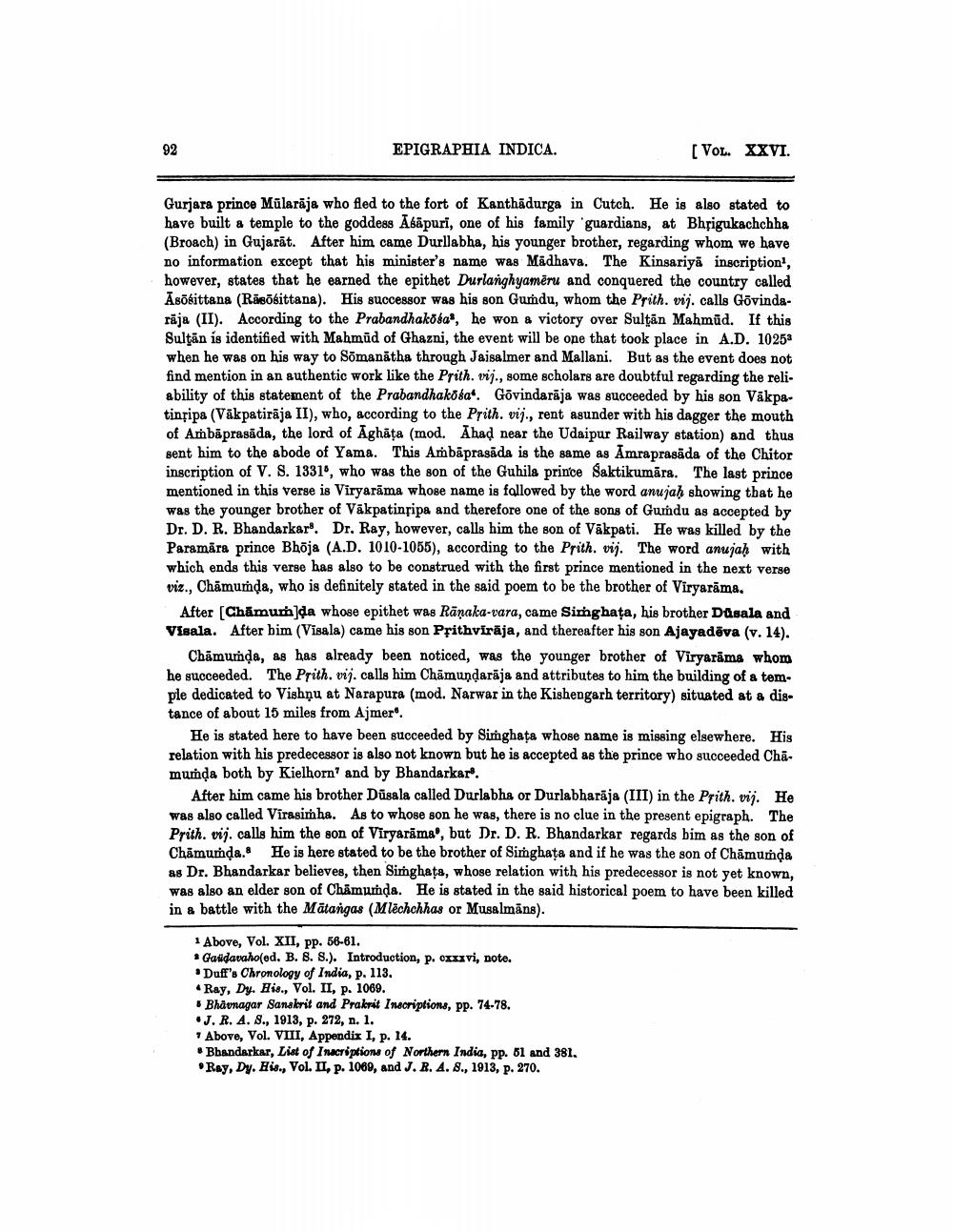________________
EPIGRAPHIA INDICA.
[VOL. XXVI.
Gurjara prince Mūlarāja who fled to the fort of Kanthädurga in Cutch. He is also stated to have built a temple to the goddess Āsāpuri, one of his family guardians, at Bhrigukachchha (Broach) in Gujarat. After him came Durllabha, his younger brother, regarding whom we have no information except that his minister's name was Mädhava. The Kinsariya inscription", however, states that he earned the epithet Durlanghyamēru and conquered the country called Asökittana (Rāsõsittana). His successor was his son Gumdu, whom the Prith. vij. calls Govindatāja (II). According to the Prabandhakota, he won a victory over Sultan Mahmud. If this Sultan is identified with Mahmud of Ghazni, the event will be one that took place in A.D. 10253 when he was on his way to Sõmanātha through Jaisalmer and Mallani. But as the event does not find mention in an authentic work like the Prith. vij., some scholars are doubtful regarding the reliability of this statement of the Prabandhakosa. Govindaraja was succeeded by his son Väkpatințipa (Vakpatirāja II), who, according to the Prith. vij., rent asunder with his dagger the mouth of Ambāprasāda, the lord of Aghāța (mod. Ahad near the Udaipur Railway station) and thus sent him to the abode of Yama. This Ambāprasāda is the same as Amraprasāda of the Chitor inscription of V. S. 1331', who was the son of the Guhila prince Saktikumāra. The last prince mentioned in this verse is Viryarāma whose name is followed by the word anujah showing that he was the younger brother of Vākpatinfipa and therefore one of the sons of Gumdu as accepted by Dr. D. R. Bhandarkar'. Dr. Ray, however, calls him the son of Väkpati. He was killed by the Paramāra prince Bhöja (A.D. 1010-1055), according to the Prith. vij. The word anujah with which ends this verse has also to be construed with the first prince mentioned in the next verse viz., Chāmumda, who is definitely stated in the said poem to be the brother of Viryarāma.
After (Chămumda whose epithet was Rāņaka-vara, came Simghata, his brother Dusala and Visala. After him (Visala) came his son Prithvirāja, and thereafter his son Ajayadēva (v. 14).
Chamunda, as has already been noticed, was the younger brother of Viryarāma whom he gucceeded. The Prith. vij.calls him Chāmundarāja and attributes to him the building of a temple dedicated to Vishnu at Narapura (mod. Narwar in the Kishengarh territory) situated at a distance of about 15 miles from Ajmer.
He is stated here to have been succeeded by Simghata whose name is missing elsewhere. His relation with his predecessor is also not known but he is accepted as the prince who succeeded Chamumda both by Kielhorn' and by Bhandarkar.
After him came his brother Düsala called Durlabha or Durlabharāja (III) in the Prith. vij. He was also called Virasimha. As to whose son he was, there is no clue in the present epigraph. The Prith. vij. calls him the son of Viryarāma', but Dr. D. R. Bhandarkar regards bim as the son of Chămumda. He is here stated to be the brother of Simghata and if he was the son of Chāmumda as Dr. Bhandarkar believes, then simghata, whose relation with his predecessor is not yet known, was also an elder son of Chamunda. He is stated in the said historical poem to have been killed in a battle with the Mätangas (Mlëchchhas or Musalmāns).
1 Above, Vol. XII, pp. 56-61.
Gaidavahood, B. 8. S.). Introduction, p. oxxxvi, note. • Duff's Chronology of India, p. 113.
Ray, Dy. His., Vol. II, p. 1069. 6 Bhavnagar Sanskrit and Prakrit Inscriptions, pp. 74-78. .J. R. A. 8., 1913, p. 272, n. 1. * Above, Vol. VIII, Appendix I, p. 14. # Bhandarkar, List of Inscriptions of Northern India, pp. 51 and 381. .Ray, Dy. His., VOL. II, p. 1069, and J. R. A. 8., 1913, p. 270.




